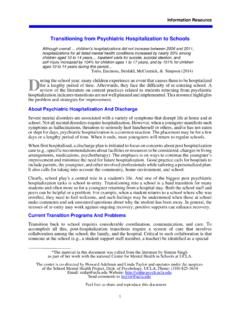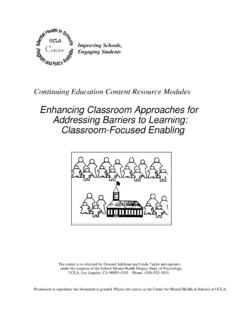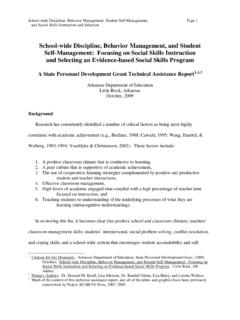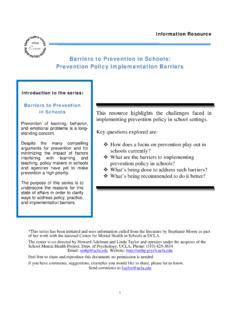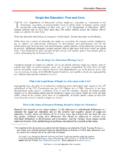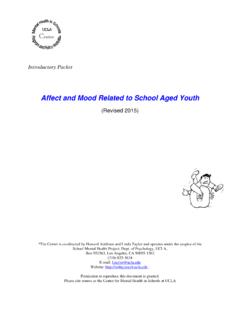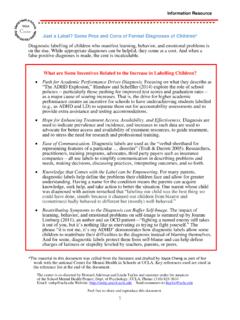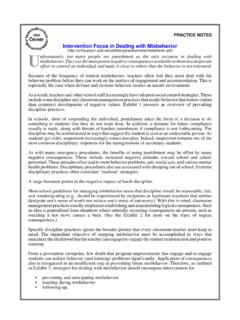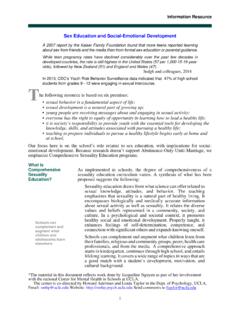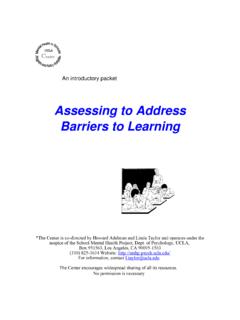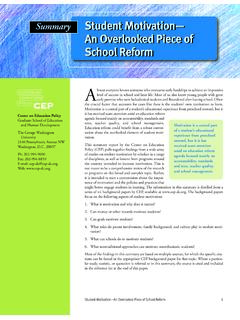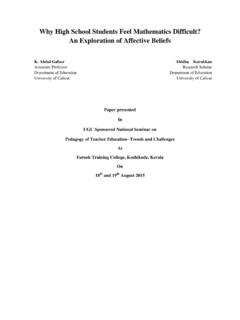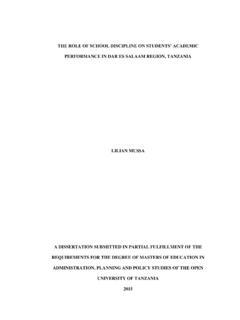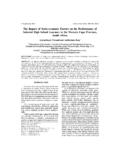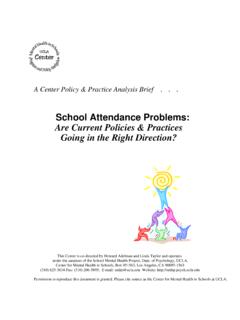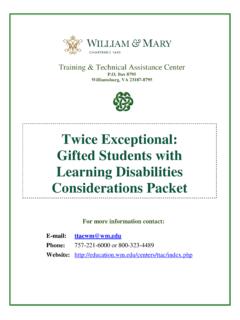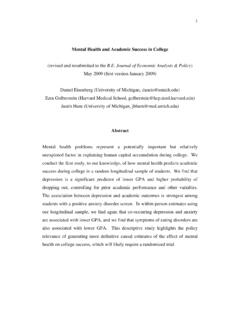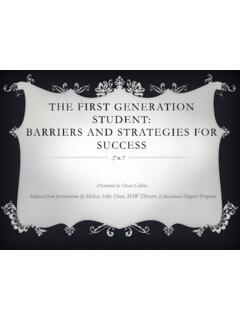Transcription of Addressing Barriers to Learning: In the Classroom and …
1 Addressing Barriers to learning : In the Classroom and SchoolwideHoward Adelman & Linda TaylorUniversity of California, Los Angeles This book was prepared by Howard Adelman and Linda Taylor, Center co-directors at UCLA, Email contact: To facilitate efforts to address Barriers to learning , this resources is freely accessible online. Permission to reproduce is school systems are not responsible for meeting every need of their students , when the need directly affects learning , the school must meet the Task Force on EducationWhy do you think we ll do betterat school this year? Because I heard that Congress passeda law that says every student will succeed!
2 Contents Introduction 1. Barriers to learning and TeachingDifferent CausesWatch Out for the LabelsBarriers and Beyond 2. Good Schools Some Basic Principles Some Added Assumptions Being Equitable, Just, and FairCreating a Positive Context for learning Toward Enhancing school and Classroom Climate An Emphasis on Caring Teachers Can't Do it AloneOpening the Door for Assistance and PartnershipsOpening the Classroom Door to Enhance and Personalize Staff Development 3. Personalizing learning : Making it More than another Buzzword Addressing Barriers to learning in the Classroom A Sequential and Hierachical Framework for Enabling Classroom learning Understanding PersonalizationDefining PersonalizationUnderlying Assumptions and Major Elements So, What Does it Take to Personalize a Classroom ?
3 Personalized Structure for LearningLearner-Valued Options and Mutual Decision MakingFlexible Interest Grouping to Enable PersonalizationHomework that Motivates Practice and Everyday Use ConferencingResponse to Intervention (RtI): Assessment to Plan; Feedback to Nurture4. Addressing learning , Behavior, and Emotional ProblemsUnderstanding Special AssistanceSequence and HierarchyAbout RemediationProviding Special Assistance in the Classroom Focusing Directly on Observable ProblemsDeveloping PrerequisitesAddressing Factors Interfering with LearningReducing Unnecessary Referrals: Response to Intervention and AccommodationsResponse to Special Assistance InterventionsA Wide Range of AccommodationsProviding Special Assistance Out of the ClassroomReferral and Care for Specialized Services A Cautionary Behavior Management: It's Not Just About Controlling Kids.
4 It's About Engaging and Re-engaging Them in LearningManaging Behavior at school : Overreliance on Strategies to Control BehaviorAbout PunishmentAbout Logical Consequences Is Skill Training an Answer?A Broad Perspective on Addressing Behavior ProblemsEngagement in learning Engagement is About MotivationValuing and Expectations: Key Components of MotivationOverreliance on RewardsDon t Lose Sight of Intrinsic MotivationRe-engaging Disconnected StudentsAddressing Underlying MotivationGeneral StrategiesA Bit More About Options and Decision Making 6. Establishing a Schoolwide Student and learning Supports ComponentThe Current State of AffairsAdopting a Component to Address Barriers to LearningDelineating the Nature and Scope of a Unified, Comprehensive, and Equitable System of learning SupportsReframing Student and learning Supports Reworking the InfrastructureSchool and Community CollaborationWhat Resources are in the Community?
5 Framing and Designing Interventions for Community Involvement and Collaborative Engagement 7. Getting From Here to ThereThe Problems of System Change Implementation and Scale-upIt s About What Happens at the school and in the ClassroomSome Key Facets of Facilitating System ChangeOperational Infrastructure for Accomplishing Systemic Change Creating Readiness, Commitment, and EngagementDesign DocumentMulti-year Strategic PlanEnsuring Policy Facilitates TransformationReworking Daily Operational InfrastructureiIntroduction Public education is at a crossroads. Moving in new directions is imperative. Just tweakingand tinkering with old ideas is a recipe for disaster.
6 Continuing challenges confronting public education highlight why moving schoolimprovement policy and practice in new directions is imperative. With a view to enhancinggraduation rates and successful transitions to post-secondary opportunities and well-being,pressing challenges include: Increasing equity of opportunity for every student to succeed, narrowing theachievement gap, and countering the school to prison pipeline Reducing unnecessary referrals for special assistance and special education; Improving school climate and retaining good teachers Reducing the number of low performing education leaders well know, meeting these challenges requires making sustainableprogress in improving supports for specific subgroups ( , English Learners, immigrantnewcomers, lagging minorities, homeless students , students with disabilities) increasing the number of disconnected students who re-engage in Classroom learningand thus improving attendance, reducing disruptive behaviors ( , including bullyingand sexual harassment)
7 , and decreasing suspensions and dropouts increasing family and community engagement with schools responding effectively when schools experience crises events and preventing criseswhenever possible. In some schools, continuous progress related to these concerns is being made. For manydistricts, however, sustainable progress remains elusive and will continue to be so as long asthe focus of school improvement policy and practice is mainly on improving instruction. Effortsto expand the use of instructional technology, develop new curriculum standards, make teachersmore accountable, and improve teacher preparation and licensing all have merit; but they areinsufficient for Addressing the many everyday Barriers to learning and teaching that interferewith effective student engagement in Classroom policy makers and administrators know that good instruction delivered by highlyqualified teachers cannot ensure that all students have an equal opportunity to succeed at the best teacher can t do the job alone.
8 Teachers need student and learning supports in theclassroom and schoolwide in order to personalize instruction and provide special assistancewhen students manifest learning , behavior, and emotional problems. Unfortunately, schoolimprovement plans continue to give short shrift to these critical matters. We recognize, as did a Carnegie Task Force on Education, that school systems are notresponsible for meeting every need of their students . But as the task force stressed: when theneed directly affects learning , the school must meet the challenge. The most pressing challenge is to enhance equity of opportunity by fundamentally improvinghow schools address Barriers to learning and teaching.
9 The future of public education depends onmoving in new directions to accomplish is the time to fundamentally transform how schools address factors that keep too manystudents from doing well at school . And while transformation is never easy, pioneering workacross the country is showing the way. Trailblazers are redeploying existing funds allocated foraddressing Barriers to learning and weaving these together with the invaluable resources that canbe garnered by collaboration with other agencies and with community stakeholders, familymembers, and students themselves. The first step in moving forward is to escape old ideas. The second step is to incorporate anew vision in school improvement planning for Addressing Barriers to learning and teaching andre-engaging disconnected students .
10 Our analyses envision a plan that designs and develops aunified, comprehensive, and equitable system of student and learning supports. The third step isto develop a strategic plan for systemic change, scale-up, and book highlights each of these matters. We invite you to join us in the quest to enhanceequity of opportunity for all students to succeed at school and beyond. And we look forward tohearing from you about moving schools forward to make the rhetoric of the Every StudentSucceeds Act a Adelman Linda Taylor 1 Barriers to learning and TeachingI failed every subject but algebra. That s not too surprising since you didn t take algebra.
